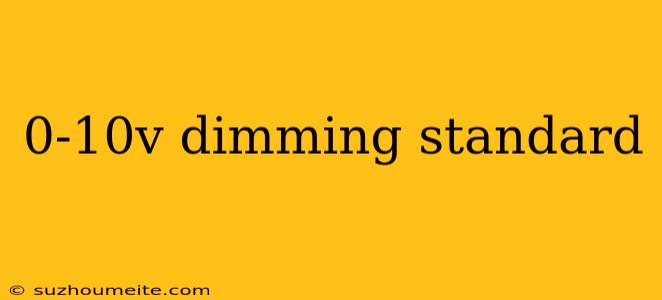0-10V Dimming Standard: Understanding the Basics
Introduction
The 0-10V dimming standard is a widely used protocol for controlling the brightness of LED lights, fluorescent lights, and other types of lighting systems. It's a popular choice among lighting designers, architects, and engineers due to its simplicity, flexibility, and ease of implementation. In this article, we'll delve into the basics of the 0-10V dimming standard, its advantages, and its applications.
How it Works
The 0-10V dimming standard uses a low-voltage signal to control the brightness of lighting fixtures. The control signal is typically provided by a controller, such as a wall switch or a building management system (BMS). The signal is then transmitted to the lighting fixture through a dedicated wire, usually a two-wire or three-wire connection.
The 0-10V signal controls the output of the lighting fixture's driver, which in turn adjusts the power supplied to the light source. As the voltage increases from 0V to 10V, the light output increases from 0% to 100%. This allows for precise control over the lighting level, enabling users to adjust the brightness to suit their needs.
Advantages
The 0-10V dimming standard offers several advantages, including:
- Easy to Implement: The 0-10V protocol is simple to understand and implement, making it a popular choice for many applications.
- High Precision: The 0-10V signal allows for precise control over the lighting level, enabling users to adjust the brightness to suit their needs.
- Flexibility: The 0-10V protocol can be used with a wide range of lighting fixtures, including LED, fluorescent, and incandescent lights.
- Low Cost: The 0-10V protocol is a cost-effective solution compared to other dimming protocols, such as DALI or DMX.
Applications
The 0-10V dimming standard is widely used in various applications, including:
- Commercial Buildings: Offices, retail stores, and restaurants often use 0-10V dimming to control lighting levels and create ambiance.
- Industrial Settings: Warehouses, factories, and other industrial facilities use 0-10V dimming to optimize lighting levels and improve safety.
- Residential Buildings: Homes and apartments use 0-10V dimming to control lighting levels and create a comfortable living environment.
- Automotive Industry: The 0-10V protocol is used in automotive applications, such as LED lighting in cars and trucks.
Conclusion
The 0-10V dimming standard is a widely used and popular protocol for controlling lighting levels in various applications. Its simplicity, flexibility, and ease of implementation make it a preferred choice among lighting designers and engineers. By understanding the basics of the 0-10V protocol, users can optimize their lighting systems and create a comfortable, energy-efficient, and productive environment.
